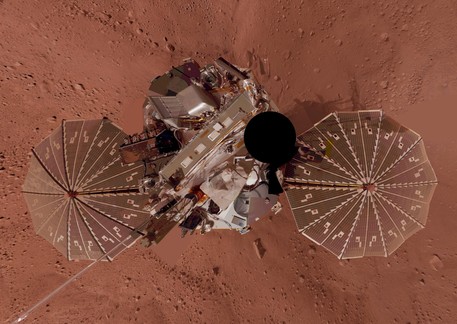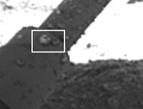Liquid water found on Mars
Phoenix has wet feet
Already shortly after the landing of the Mars Lander Phoenix on the Red Planet the pictures broadcast back to earth showed strange spots on the legs of the Lander. The legs were used to land and the spots on them changed over time: some got bigger, merged and seemed to move downwards.
 © NASA
|
Self-Portrait: Phoenix on the Mars
After a long debate amongst the scientists they arrived at the conclusion that the observed phenomenon had to be water. The scientists want to present their findings in March at the “Lunar- and Planetary Science Conference” in Houston. The first account however was already given in a British science magazine.
Phoenix landed on the outskirts of the north polar region of the Red Planet on May 25th. Usually it is far too cold on the surface of Mars for water to be liquid. At the landing place for example the temperature never exceeds -4 Fahrenheit. However the scientists around Nilton Renno of the University of Michigan argue that salt could serve as a sort of defroster and keep the water liquid at extremely low temperatures.
In accordance with that theory at the landing spot perchlorates were identified. If the concentration of these kinds of salt is high enough water can stay liquid at temperatures as low as -90 degrees Fahrenheit. During the landing ice could have melted in the upper ground layers. Some drops of that water could have clung to the legs of Phoenix. Since perchlorates attract water the drops could have grown by extracting water from the atmosphere.
Since Phoenix is frozen now the scientists have no possibility to further investigate what they believe to be water drops. According to Renno the high concentration of the perchlorates could suggest a layer of liquid water right underneath the dusty surface. With the possibility of water, the growth of microorganisms could be enabled. However it remains unclear if they could exist with such high salt concentrations.
Rainer Kayser, PhD is a journalist in Hamburg
Liquid water found on Mars
Phoenix has wet feet
Already shortly after the landing of the Mars Lander Phoenix on the Red Planet the pictures broadcast back to earth showed strange spots on the legs of the Lander. The legs were used to land and the spots on them changed over time: some got bigger, merged and seemed to move downwards.
 © NASA
|
Self-Portrait: Phoenix on the Mars
After a long debate amongst the scientists they arrived at the conclusion that the observed phenomenon had to be water. The scientists want to present their findings in March at the “Lunar- and Planetary Science Conference” in Houston. The first account however was already given in a British science magazine.
Phoenix landed on the outskirts of the north polar region of the Red Planet on May 25th. Usually it is far too cold on the surface of Mars for water to be liquid. At the landing place for example the temperature never exceeds -4 Fahrenheit. However the scientists around Nilton Renno of the University of Michigan argue that salt could serve as a sort of defroster and keep the water liquid at extremely low temperatures.
In accordance with that theory at the landing spot perchlorates were identified. If the concentration of these kinds of salt is high enough water can stay liquid at temperatures as low as -90 degrees Fahrenheit. During the landing ice could have melted in the upper ground layers. Some drops of that water could have clung to the legs of Phoenix. Since perchlorates attract water the drops could have grown by extracting water from the atmosphere.
Since Phoenix is frozen now the scientists have no possibility to further investigate what they believe to be water drops. According to Renno the high concentration of the perchlorates could suggest a layer of liquid water right underneath the dusty surface. With the possibility of water, the growth of microorganisms could be enabled. However it remains unclear if they could exist with such high salt concentrations.
Rainer Kayser, PhD is a journalist in Hamburg








